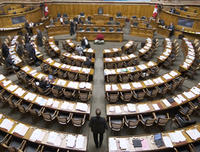
This is only part of what sets the Swiss executive branch apart from other governments in the world.
Instead of executive power being vested in an individual, it is held by a committee. Unlike other countries, there is no prime minister or head of state.
Since 1848, the Swiss cabinet, known as the Federal Council, has consisted of seven members.
The Federal Council has been composed of the same political parties for more than 60 years. By common agreement Switzerland's four main parties divide the seven cabinet seats according to a set formula determined ultimately by their strength at the ballot box.
Consensus
The Federal Council follows an unwritten principle of "collegiality". Once its differences are settled and decisions taken, all cabinet ministers defend them. Thus, it is not unusual for ministers to have to represent policies that do not necessarily reflect their own views.
The Swiss constitution actually requires that the government take executive decisions collectively. Official communications begin, "The Federal Council has decided..."
Ministries
Each of the seven cabinet ministers has equal power, and each is responsible for one department, or ministry, the structure of which has changed remarkably little since 1848. Because there are only seven ministries, ministers have a heavy workload. Attempts at reform have failed until now.
As the ministry head, a cabinet minister manages a hierarchical administrative structure of up to 12,000 employees. Some departments comprise a variety of portfolios that in other countries might be divided up into multiple ministries.
The ministries are the following: the defense ministry; the economics ministry; the transport, environment, communications and energy ministry; the finance ministry; the foreign ministry; the justice and police ministry; and the interior ministry.
Presidency
The Swiss presidency is rotated annually. According to an unwritten agreement, cabinet ministers take turns serving as president of the confederation, with newer members waiting until seniors have served.
Even though the Swiss president chairs council meetings and represents the country at home and abroad, he or she is considered a "first among equals", and not a leader.
The head of state, formally speaking, is the Federal Council. Its seven members are not elected by the people but by parliament.
During state visits, foreign dignitaries are received by the Federal Council as a whole, not by the minister serving as president.
Elections
The houses of parliament elect cabinet ministers in joint session. Parliament cannot remove cabinet ministers from office, nor can ministers dissolve parliament.
Each year in December, parliament elects a president and a vice president of the confederation.
In December of election years, when the newly elected parliament meets for the first time, each of the cabinet ministers is elected for a term of four years. There is a marked reluctance to remove ministers from office. It has happened only twice, the last time in 2003.
Cabinet ministers may not hold any other official positions or be members of parliament while serving. But, unlike the US president, they must and do take part in parliamentary debates, defending the government's standpoint in parliament.
Technically, every person who is entitled to vote can stand for election to the Federal Council. In reality, it is generally parliamentarians who are put forward, although representatives of cantonal governments have also been elected to the Federal Council.
Balance
The balancing of interests, languages and regions in the Federal Council is traditionally a key concern. A law banning more than one minister from the same canton from serving in the Federal Council was repealed in 1999. Today the constitution states merely that "geographical and linguistic regions must be appropriately represented".
As Italian-speaking Switzerland has not been represented in the cabinet for several years, the election chances of any prospective candidate from canton Ticino are automatically improved.
For a long time, it was an unwritten rule that the three largest cantons – Zurich, Bern and Vaud – should be represented in the cabinet. In recent years, however, Geneva has taken precedence over Vaud.
As of 2009 only six women have ever served as cabinet ministers, and just two as president.
History
Established with the creation of the Swiss federal state in 1848, the Federal Council was given more responsibilities than its predecessors.
Initially, it was a one-party government, with all members belonging to the Radical party, which was victorious in the short civil war of 1847, and which created the present government system.
Despite this monopoly, the diversity of the country was taken into account in distributing cabinet seats, with two of the seven seats reserved for Catholics, and another two for non-German speakers.
In response to changing political realities, the one party system slowly made way for others.
In 1891 the centre-right Christian Democrats earned a seat, then were awarded a second one after the First World War. The predecessor to the rightwing Swiss People's Party got their first seat in 1929, and the centre-left Social Democrats in 1943.
"Magic Formula"
The election of two Social Democrats to the Federal Council in 1959 established the so-called "Magic Formula" 2-2-2-1, which meant two cabinet seats each for the Radicals, Christian Democrats and Social Democrats, and a single seat for the People's Party. This arrangement remained stable for more than 40 years.
The sharing out of cabinet seats was in effect just a reflection of the proportional strength of the main parties in parliament. The growing power of the People's Party in the past two legislatures has led to a realignment of the 2-2-2-1 system, with Christian Democrats having to cede one of their seats to the People's Party after the 2003 elections.
Four years later, the People's Party strongman Christoph Blocher was voted out and replaced by a - more moderate - woman.
Article provided by swissinfo. For latest news on Switzerland, check swissinfo.ch .

